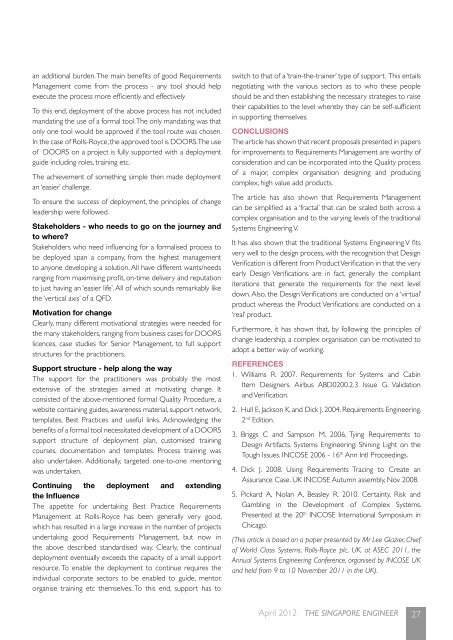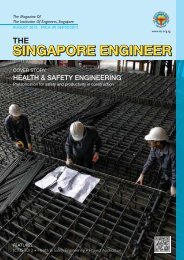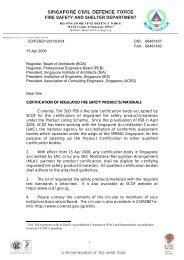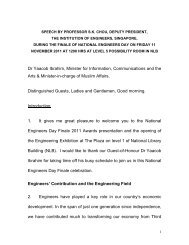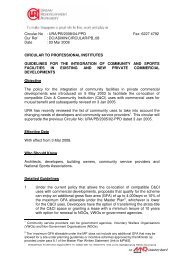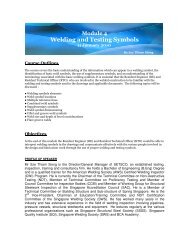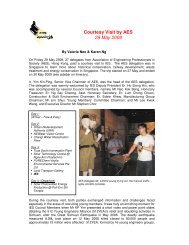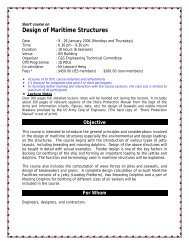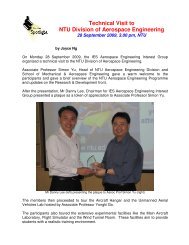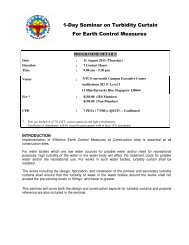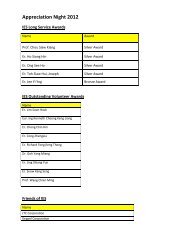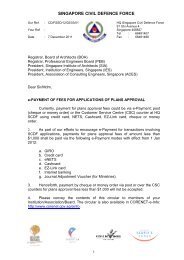THE SINGAPORE ENGINEER - Institution of Engineers Singapore
THE SINGAPORE ENGINEER - Institution of Engineers Singapore
THE SINGAPORE ENGINEER - Institution of Engineers Singapore
You also want an ePaper? Increase the reach of your titles
YUMPU automatically turns print PDFs into web optimized ePapers that Google loves.
an additional burden. The main benefits <strong>of</strong> good Requirements<br />
Management come from the process - any tool should help<br />
execute the process more efficiently and effectively<br />
To this end, deployment <strong>of</strong> the above process has not included<br />
mandating the use <strong>of</strong> a formal tool. The only mandating was that<br />
only one tool would be approved if the tool route was chosen.<br />
In the case <strong>of</strong> Rolls-Royce, the approved tool is DOORS. The use<br />
<strong>of</strong> DOORS on a project is fully supported with a deployment<br />
guide including roles, training etc.<br />
The achievement <strong>of</strong> something simple then made deployment<br />
an ‘easier’ challenge.<br />
To ensure the success <strong>of</strong> deployment, the principles <strong>of</strong> change<br />
leadership were followed.<br />
Stakeholders - who needs to go on the journey and<br />
to where?<br />
Stakeholders who need influencing for a formalised process to<br />
be deployed span a company, from the highest management<br />
to anyone developing a solution. All have different wants/needs<br />
ranging from maximising pr<strong>of</strong>it, on-time delivery and reputation<br />
to just having an ‘easier life’. All <strong>of</strong> which sounds remarkably like<br />
the ‘vertical axis’ <strong>of</strong> a QFD.<br />
Motivation for change<br />
Clearly, many different motivational strategies were needed for<br />
the many stakeholders, ranging from business cases for DOORS<br />
licences, case studies for Senior Management, to full support<br />
structures for the practitioners.<br />
Support structure - help along the way<br />
The support for the practitioners was probably the most<br />
extensive <strong>of</strong> the strategies aimed at motivating change. It<br />
consisted <strong>of</strong> the above-mentioned formal Quality Procedure, a<br />
website containing guides, awareness material, support network,<br />
templates, Best Practices and useful links. Acknowledging the<br />
benefits <strong>of</strong> a formal tool necessitated development <strong>of</strong> a DOORS<br />
support structure <strong>of</strong> deployment plan, customised training<br />
courses, documentation and templates. Process training was<br />
also undertaken. Additionally, targeted one-to-one mentoring<br />
was undertaken.<br />
Continuing the deployment and extending<br />
the Influence<br />
The appetite for undertaking Best Practice Requirements<br />
Management at Rolls-Royce has been generally very good,<br />
which has resulted in a large increase in the number <strong>of</strong> projects<br />
undertaking good Requirements Management, but now in<br />
the above described standardised way. Clearly, the continual<br />
deployment eventually exceeds the capacity <strong>of</strong> a small support<br />
resource. To enable the deployment to continue requires the<br />
individual corporate sectors to be enabled to guide, mentor,<br />
organise training etc themselves. To this end, support has to<br />
switch to that <strong>of</strong> a ‘train-the-trainer’ type <strong>of</strong> support. This entails<br />
negotiating with the various sectors as to who these people<br />
should be and then establishing the necessary strategies to raise<br />
their capabilities to the level whereby they can be self-sufficient<br />
in supporting themselves.<br />
CONCLUSIONS<br />
The article has shown that recent proposals presented in papers<br />
for improvements to Requirements Management are worthy <strong>of</strong><br />
consideration and can be incorporated into the Quality process<br />
<strong>of</strong> a major, complex organisation designing and producing<br />
complex, high value add products.<br />
The article has also shown that Requirements Management<br />
can be simplified as a ‘fractal’ that can be scaled both across a<br />
complex organisation and to the varying levels <strong>of</strong> the traditional<br />
Systems Engineering V.<br />
It has also shown that the traditional Systems Engineering V fits<br />
very well to the design process, with the recognition that Design<br />
Verification is different from Product Verification in that the very<br />
early Design Verifications are in fact, generally the compliant<br />
iterations that generate the requirements for the next level<br />
down. Also, the Design Verifications are conducted on a ‘virtual’<br />
product whereas the Product Verifications are conducted on a<br />
‘real’ product.<br />
Furthermore, it has shown that, by following the principles <strong>of</strong><br />
change leadership, a complex organisation can be motivated to<br />
adopt a better way <strong>of</strong> working.<br />
REFERENCES<br />
1. Williams R. 2007. Requirements for Systems and Cabin<br />
Item Designers. Airbus ABD0200.2.3 Issue G. Validation<br />
and Verification.<br />
2. Hull E, Jackson K, and Dick J. 2004. Requirements Engineering.<br />
2 nd Edition.<br />
3. Briggs C and Sampson M. 2006. Tying Requirements to<br />
Design Artifacts. Systems Engineering: Shining Light on the<br />
Tough Issues. INCOSE 2006 - 16 th Ann Intl Proceedings.<br />
4. Dick J. 2008. Using Requirements Tracing to Create an<br />
Assurance Case. UK INCOSE Autumn assembly, Nov 2008.<br />
5. Pickard A, Nolan A, Beasley R. 2010. Certainty, Risk and<br />
Gambling in the Development <strong>of</strong> Complex Systems.<br />
Presented at the 20 th INCOSE International Symposium in<br />
Chicago.<br />
(This article is based on a paper presented by Mr Lee Glazier, Chief<br />
<strong>of</strong> World Class Systems, Rolls-Royce plc, UK, at ASEC 2011, the<br />
Annual Systems Engineering Conference, organised by INCOSE UK<br />
and held from 9 to 10 November 2011 in the UK).<br />
April 2012 <strong>THE</strong> <strong>SINGAPORE</strong> <strong>ENGINEER</strong><br />
27


